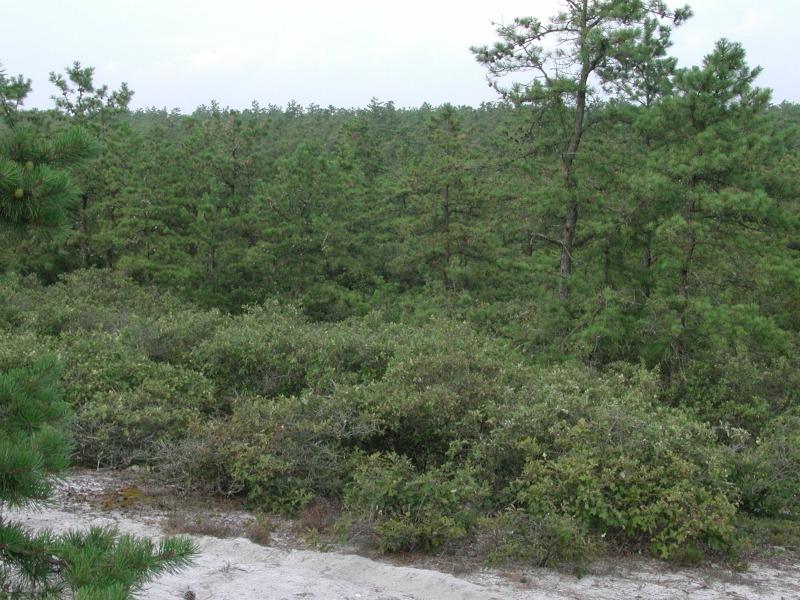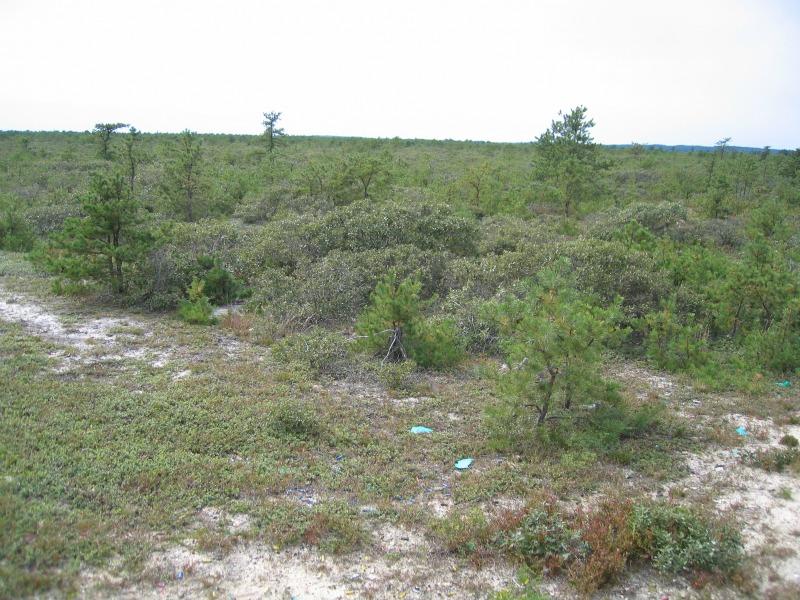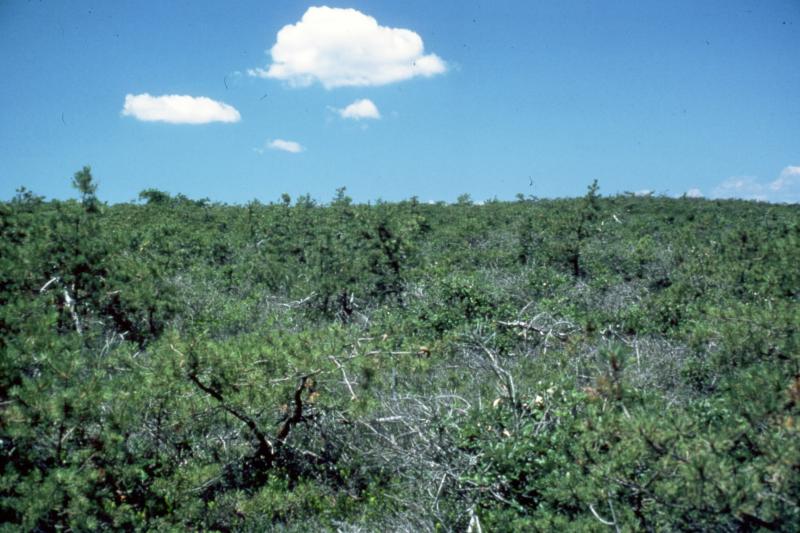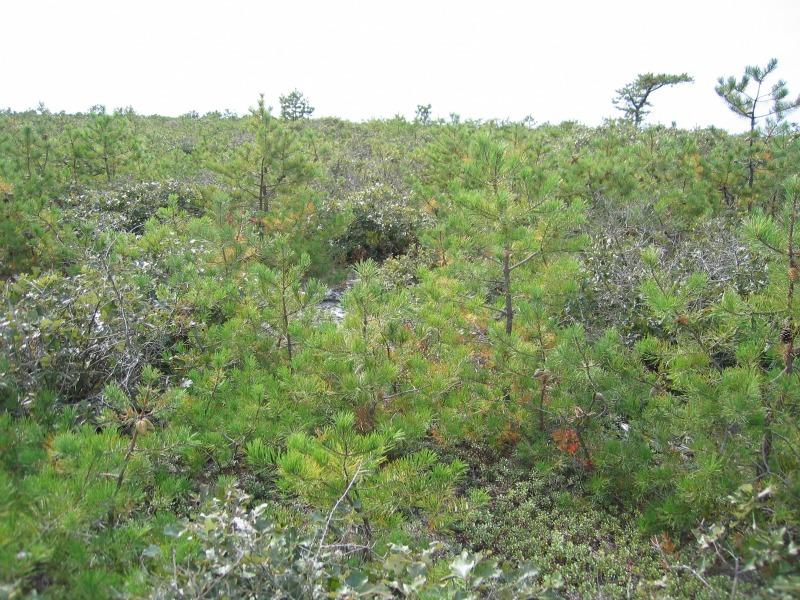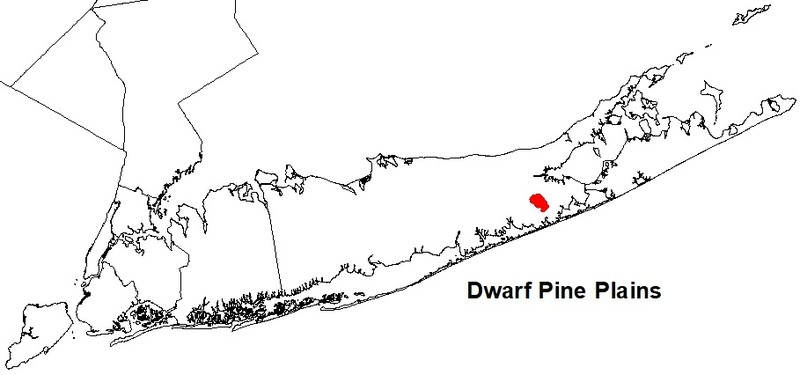Dwarf Pine Plains
- System
- Terrestrial
- Subsystem
- Barrens And Woodlands
- State Protection
- Not Listed
Not listed or protected by New York State.
- Federal Protection
- Not Listed
- State Conservation Status Rank
- S1
Critically Imperiled in New York - Especially vulnerable to disappearing from New York due to extreme rarity or other factors; typically 5 or fewer populations or locations in New York, very few individuals, very restricted range, very few remaining acres (or miles of stream), and/or very steep declines.
- Global Conservation Status Rank
- G1G2
Critically Imperiled or Imperiled globally - At very high or high risk of extinction due to rarity or other factors; typically 20 or fewer populations or locations in the world, very few individuals, very restricted range, few remaining acres (or miles of stream), and/or steep declines. More information is needed to assign either G1 or G2.
Summary
Did you know?
"Fire fight at sunrise! Drought-racked pine woods of Long Island's Suffolk county has worst wildfire in New York State for a century." That was the headline in the papers the summer of 1995. 7000 acres of pine barren forest burned over an 11 day period. 2000 firefighters came to fight the blaze. Two hundred members of the U.S. Forest Service's elite Hot Shot crews and fire management staff flew in from the West. There were minor injuries, some property damage, and luckily no deaths. The fire was named for the Sunrise Highway that passes through the pine barrens. But the pine barrens came back. Just one week after the Sunrise Fire, tiny green sprouts pushed up through the ashes that blanketed the base of scrub oaks. Two weeks after the fire, the pines began sending up sprouts. By October, those little oak sprouts had grown more than a foot tall (Beil 1995). Pine barrens are a fire dependent natural community. Periodic fires are necessary to maintain the unique species composition.
State Ranking Justification
The dwarf pine plains natural community is restricted to the coastal lowlands in eastern Long Island. There is only one large, over 1000 acre, site for this community type in New York.
Short-term Trends
The acreage of dwarf pine plains in New York have probably decreased in recent decades as a result of residential and commercial development. Presently, there is only one large (about 1300 acres), albeit fragmented, occurrence of this community type.
Long-term Trends
The acreage of dwarf pine plains in New York have probably declined substantially from historical acreage. Although there is one very large occurrence on Long Island (about 1300 acres) it was probably much larger before settlement and development.
Conservation and Management
Threats
The major threat to this community is residential and commercial development of the land. Development of the land leads to fragmentation of the forest and fire suppression. This particular community is a "fire dependent" community. Periodic fires are necessary to maintain the unique species composition of this forest type. Southern pine beetle (Dendroctonus frontalis) is a bark beetle that infests pine trees, such as pitch pine, white pine, and red pine. Southern pine beetle is native to the southeastern United States, but its range has spread up the east coast to Long Island, New York in 2014. Natural communities dominated or co-dominated by pines would likely be most impacted by southern pine beetle invasion.
Conservation Strategies and Management Practices
Develop and implement prescribed burn plans at appropriate sites. Reduce or minimize fragmenting features, such as residential and commercial development, roads, abandoned clearings, unnecessary trails, etc. Restrict mountain bikes and ATVs to designated trails and least sensitive areas, and prevent dumping of trash. Remove or control invasive species where appropriate.
Development and Mitigation Considerations
Soils are very thin within this community, and the effect of clearing and construction on soil retention and erosion must be considered during any development activities. Similarly, these soils are acidic and nutrient-poor and any soil enrichment contamination (e.g., from septic leach fields or fertilized lawns) can alter community structure and function. The open structure of this community is maintained by fire and presents a fire hazard to existing and proposed development. Unprotected structures located within or near this community are more susceptible to damage from fire.
Inventory Needs
Survey for other occurrences to advance the documentation and classification of pine barrens. In addition, quantitative data on community composition, especially herbs, lichens, invertebrates, and small mammals are needed.
Research Needs
Research is needed to determine optimal fire regime for this community. Assess how human alterations in the landscape affect pine barrens.
Rare Species
- Anisota stigma (Spiny Oakworm Moth) (guide)
- Atrytonopsis hianna (Dusted Skipper) (guide)
- Catocala herodias gerhardi (Herodias or Pine Barrens Underwing) (guide)
- Catocala jair ssp. 2 (Jersey Jair Underwing) (guide)
- Chaetaglaea cerata (Waxed Sallow) (guide)
- Chordeiles minor (Common Nighthawk) (guide)
- Cicinnus melsheimeri (Melsheimer's Sack Bearer) (guide)
- Circus hudsonius (Northern Harrier) (guide)
- Cisthene packardii (Packard's Lichen Moth) (guide)
- Cleora projecta (Projecta Gray) (guide)
- Dasychira pinicola (Pine Tussock Moth) (guide)
- Desmodium ciliare (Hairy Small-leaved Tick Trefoil) (guide)
- Euchlaena madusaria (A Geometrid Moth) (guide)
- Eupatorium subvenosum (Veined Thoroughwort) (guide)
- Euxoa pleuritica (Fawn Brown Dart) (guide)
- Euxoa violaris (Violet Dart) (guide)
- Hemileuca maia ssp. 5 (Coastal Barrens Buckmoth) (guide)
- Heterocampa varia (A Prominent Moth) (guide)
- Hyperstrotia flaviguttata (Yellow-spotted Graylet) (guide)
- Lithophane viridipallens (Pale Green Pinion Moth) (guide)
- Lithospermum canescens (Hoary Puccoon) (guide)
- Monoleuca semifascia (Pin-striped Slug Moth) (guide)
- Morrisonia mucens (Gray Woodgrain) (guide)
- Psectraglaea carnosa (Pink Sallow) (guide)
- Schinia spinosae (Spinose Flower Moth) (guide)
- Speranza exonerata (Barrens Itame) (guide)
- Sphinx gordius (Gordian Sphinx) (guide)
- Virbia aurantiaca (Orange Holomelina) (guide)
- Zale lunifera (Pine Barrens Zale) (guide)
Range
New York State Distribution
The dwarf pine plains natural community is restricted to the coastal lowlands in eastern Long Island. There is only one large (1300 acre) site for this community type in New York.
Global Distribution
The New York dwarf pine barrens on Long Island is the only known location of this particular community type. There is, however, a taxonomic overlap with other pine barrens associations occurring on Cape Cod and Nantucket, Massachusetts and possibly New Jersey. Pine barrens, in general, are rare and threatened throughout their range (NatureServe 2009).
Best Places to See
- Central Long Island Pine Barrens (Suffolk County)
Identification Comments
General Description
This is a woodland community dominated by dwarf individuals of pitch pine (Pinus rigida) and scrub oak (Quercus ilicifolia) that occurs on nearly level outwash sand and gravel plains in eastern Long Island. The soils are infertile, coarse textured sands that are excessively well-drained. The canopy of dwarf pitch pines and scrub oaks is generally from 1.2 to 2.4 m (4 to 8 ft) tall, and it may form a dense thicket. The community includes very few species of vascular plants.
Characters Most Useful for Identification
This natural community is mainly identified by the dwarf individuals of pitch pine and scrub oak and by topographical location on nearly level outwash sand and gravel plains in eastern Long Island.
Elevation Range
Known examples of this community have been found at elevations between 20 feet and 120 feet.
Best Time to See
The best time to see this natural community is in the spring, when the weather is favorable and there is a chance to see and hear birds such as prairie warbler (Dendroica discolor) and brown thrasher (Toxostoma rufum); two species that favor this habitat for breeding.
Dwarf Pine Plains Images
Classification
International Vegetation Classification Associations
This New York natural community encompasses all or part of the concept of the following International Vegetation Classification (IVC) natural community associations. These are often described at finer resolution than New York's natural communities. The IVC is developed and maintained by NatureServe.
- Pitch Pine - Bear Oak / Bearberry Scrub (CEGL006097)
NatureServe Ecological Systems
This New York natural community falls into the following ecological system(s). Ecological systems are often described at a coarser resolution than New York's natural communities and tend to represent clusters of associations found in similar environments. The ecological systems project is developed and maintained by NatureServe.
- Northern Atlantic Coastal Plain Pitch Pine Barrens (CES203.269)
Characteristic Species
-
Shrubs 2 - 5m
- Pinus rigida (pitch pine)
-
Shrubs < 2m
- Arctostaphylos uva-ursi (bearberry)
- Gaylussacia baccata (black huckleberry)
- Hudsonia ericoides (golden-heather)
- Pinus rigida (pitch pine)
- Quercus ilicifolia (scrub oak, bear oak)
- Vaccinium pallidum (hillside blueberry)
-
Herbs
- Crocanthemum canadense (Canada frostweed, Canada rock-rose)
- Cyperus houghtonii (Houghton's flat sedge)
- Gaultheria procumbens (wintergreen, teaberry)
- Hypericum gentianoides (orange-grass)
- Ionactis linariifolia (stiff-leaved-aster)
- Melampyrum lineare (cow-wheat)
- Polygonum articulatum (northern jointweed)
-
Nonvascular plants
- British soldiers lichen (Cladonia cristatella)
- dog-lichen (Peltigera canina)
- dune reindeer lichen (Cladonia submitis)
- green reindeer lichen (Cladonia mitis)
- rough speckled shield lichen (Punctelia rudecta)
- salted shield lichen (Parmelia saxatilis)
- sand-loving Iceland lichen (Cetraria arenaria)
- star-tipped reindeer lichen (Cladonia stellaris)
Similar Ecological Communities
- Dwarf pine ridges
(guide)
This forested community is also dominated by dwarf individuals of pitch pine (Pinus rigida) along with black huckleberry (Gaylussacia baccata), but occurs on flat-topped summits of rocky ridges. Scrub oak (Quercus ilicifolia) is not abundant in this community. The bedrock is a white quartzite conglomerate; soils are very thin, and they are rich in organic matter from litter that has accumulated on the bedrock.
- Maritime pitch pine dune woodland
(guide)
This is a maritime woodland that occurs on stabilized parabolic dunes. The substrate is wind and wave deposited sand that is excessively well-drained and nutrient poor. The community is subject to high winds, sand-blasting, salt spray, and shifting substrate. Maritime pitch pine dune woodlands differ from dwarf pine plains by having constant maritime influences. The tree canopy, primarily pitch pine with some oaks, is sparse, stunted, and salt pruned.
- Pitch pine-heath barrens
(guide)
This is a shrub-savanna community that occurs on well-drained, sandy or rocky soils only in northern New York. This is a broadly defined community with several regional variants. The most abundant tree is pitch pine (Pinus rigida); in some stands there is a mixture of one or more species including big tooth aspen (Populus grandidentata), white pine (Pinus strobus), or jack pine (P. banksiana). The percent cover of trees is variable, ranging from 30 to 60%. The shrublayer is much more developed compared with dwarf pine plains, and is dominated by heath shrubs such as black huckleberry (Gaylussacia baccata), blueberries (Vaccinium angustifolium, V. pallidum, and V. myrtilloides), and sheep-laurel (Kalmia angustifolia), as well as sweet-fern (Comptonia peregrina). This shrublayer may be quite diverse when compared to dwarf pine plains.
- Pitch pine-scrub oak barrens
(guide)
This is a shrub-savanna community that occurs on well-drained, sandy soils that have developed on sand dunes, glacial till, and outwash plains. The pitch pine trees within this community type are not generally as stunted as in dwarf pine plains, they occur as scattered individuals and can be emergent over thickets of scrub oak. There is also a greater diversity of plants within pitch pine-scrub oak barrens compared to dwarf pine plains.
Vegetation
Percent cover
This figure helps visualize the structure and "look" or "feel" of a typical Dwarf Pine Plains. Each bar represents the amount of "coverage" for all the species growing at that height. Because layers overlap (shrubs may grow under trees, for example), the shaded regions can add up to more than 100%.
Additional Resources
References
Beil, Karen M.. 1995. Fire fight at sunrise. Drought-racked pine woods of Long Island's Suffolk county has worst wildfire in New York State for a century: includes a related article on nature's regreening of the burnt area). New York State Conservationist. Albany. NY.
Cryan, J.F. 1982. The Long Island dwarf Pine Plains: Pygmy Forest of the Pine Barrens. The Heath Hen (1)4:2-33.
Edinger, G. J., D. J. Evans, S. Gebauer, T. G. Howard, D. M. Hunt, and A. M. Olivero (editors). 2014. Ecological Communities of New York State. Second Edition. A revised and expanded edition of Carol Reschke’s Ecological Communities of New York State. New York Natural Heritage Program, New York State Department of Environmental Conservation, Albany, NY. https://www.nynhp.org/ecological-communities/
Edinger, Gregory J., D.J. Evans, Shane Gebauer, Timothy G. Howard, David M. Hunt, and Adele M. Olivero (editors). 2002. Ecological Communities of New York State. Second Edition. A revised and expanded edition of Carol Reschke's Ecological Communities of New York State. (Draft for review). New York Natural Heritage Program, New York State Department of Environmental Conservation. Albany, NY. 136 pp.
Grossman, D. H., K. Lemon Goodin, and C. L. Reuss, editors. 1994. Rare plant communities of the conterminous United States: An initial survey. The Nature Conservancy. Arlington, VA. 620 pp.
Jordan, M. 1998. Ecological effect of a large and severe summer wildfire in the Long Island dwarf pine barrens. Unpublished report. The Nature Conservancy, Long Island Chapter, Cold Spring Harbor, NY.
Jordan, M. J., W. A. Patterson III, A. G. Windisch. 2003. Conceptual ecological models for the Long Island pitch pine barrens: implications for managing rare plant communities. Forest Ecology and Management 185, 151-168.
Kerlinger, P. and C. Doremus. 1981. The breeding birds of three pine barrens in New York State. The Kingbird 31:126-135.
NatureServe. 2015. NatureServe Explorer: An online encyclopedia of life [web application]. Version 7.1. NatureServe, Arlington, Virginia. Available http://www.natureserve.org/explorer.
New York Natural Heritage Program. 2024. New York Natural Heritage Program Databases. Albany, NY.
Olsvig, L.S. 1980. A comparative study of northeastern Pine Barrens vegetation. Ph.D. dissertation, Cornell University, Ithaca, NY. 479 pp.
Olsvig, L.S., J.F. Cryan and R.H. Whittaker. 1979. Vegetational gradients of the pine plains and barrens of Long Island, New York. In: Forman, R.T.T. ed. 1979. Pine Barrens: Ecosystems and Landscape.
Reschke, Carol. 1990. Ecological communities of New York State. New York Natural Heritage Program, New York State Department of Environmental Conservation. Latham, NY. 96 pp. plus xi.
Links
About This Guide
This guide was authored by: Shereen Brock
Information for this guide was last updated on: December 12, 2023
Please cite this page as:
New York Natural Heritage Program. 2024.
Online Conservation Guide for
Dwarf pine plains.
Available from: https://guides.nynhp.org/dwarf-pine-plains/.
Accessed July 26, 2024.
